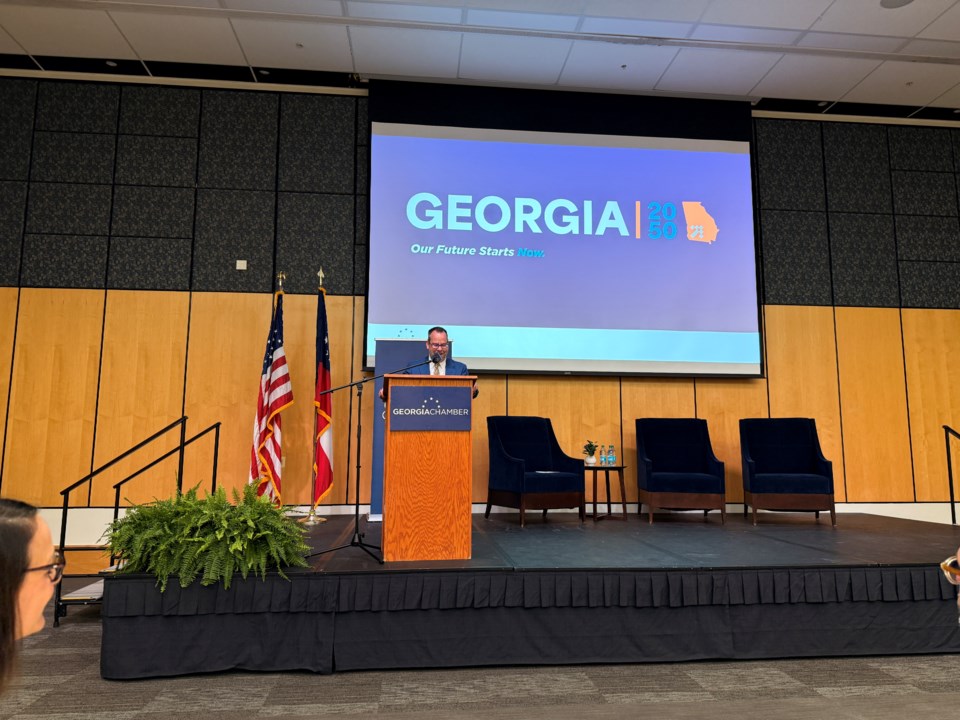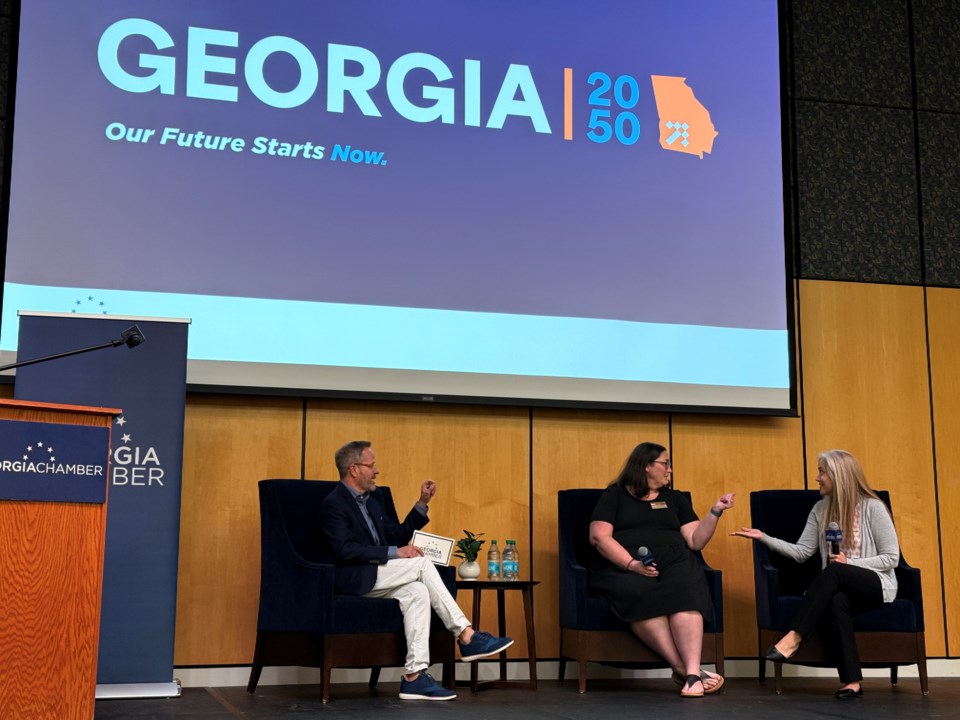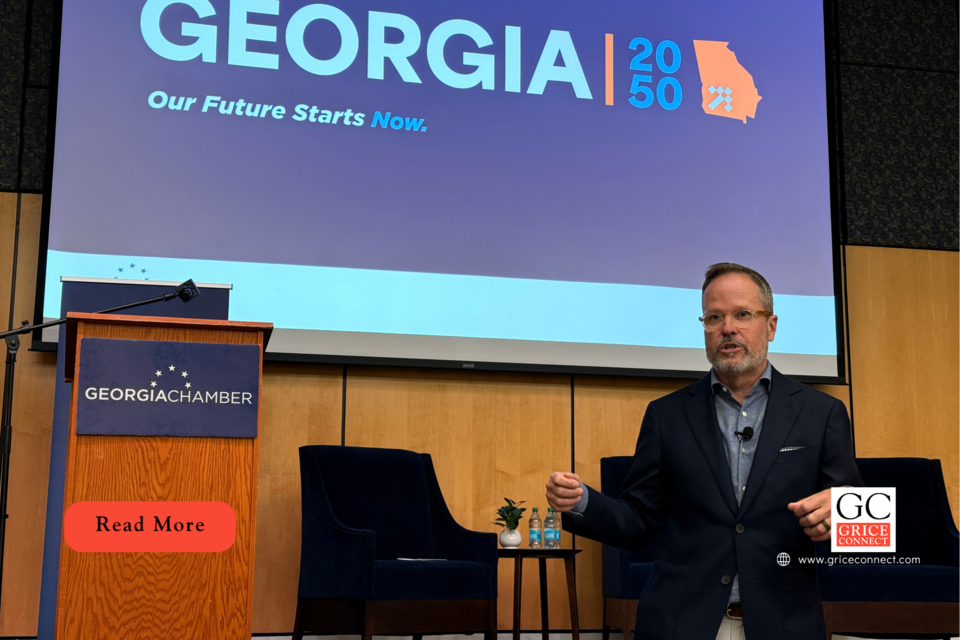The Georgia Chamber of Commerce brought its “Georgia 2050” initiative to Statesboro on Tuesday, June 3, holding a regional forum at Georgia Southern University’s Performing Arts Center.
The event focused on long-term planning around economic development, workforce needs, and public health as Georgia prepares for significant population growth over the next two decades.
The Georgia Chamber represents businesses across the state and works to support economic growth through policy, research, and partnerships. Its Georgia 2050 campaign is aimed at helping communities plan for the future by looking at data and trends that will shape jobs, infrastructure, and demographics statewide.

Tuesday’s program opened with a welcome from Dr. Kyle Marrero, President of Georgia Southern University, who shared recent university milestones including record enrollment, increased research funding, and the upcoming merger with East Georgia State College.
He then turned the program over to Jennifer Davis, President and CEO of the Statesboro-Bulloch Chamber of Commerce, who introduced the keynote speaker, Chris Clark.

Chris Clark, President and CEO of the Georgia Chamber of Commerce, delivered the keynote address, laying out what Georgia could look like by 2050 and what it will take to prepare. He said the state is expected to grow by about 2.5 million people over the next 25 years, driven by both migration and local development.
While Atlanta will continue to grow, Clark said cities like Savannah, Augusta, Macon, and rural communities like Statesboro are expected to see some of the highest growth rates.
Clark stressed that this growth brings both opportunities and challenges. One major issue is workforce readiness. With more than 100,000 Baby Boomers retiring each day nationwide, Georgia could see over 12 million job vacancies by 2030. Meanwhile, younger generations are entering the workforce with different expectations, and many lack the experience or training needed for in-demand jobs.
“Today’s college graduates are the most unemployed group in Georgia,” Clark said. “They have degrees, but not always the skills.”
He encouraged employers to rethink how they recruit and train new workers, especially younger employees from Gen Z and Gen Alpha. These generations are more diverse than any before—Georgia is on track to become a majority-minority state, with the Latino population expected to double and mixed-race populations growing rapidly.
Clark also outlined expected job growth across sectors. Healthcare is projected to see the largest increase, with openings expected to rise from 43,000 today to over 130,000 by 2032. Other fast-growing fields include clean energy, advanced manufacturing, engineering, logistics, and cybersecurity.
He noted that Georgia has already seen more than $23 billion in clean tech investment in the last five years, with average salaries in that sector topping $100,000.
In addition to job growth, Clark highlighted infrastructure and energy demands. Georgia will need 57% more power by 2050 to support new homes, businesses, and data use. He also pointed out that roads and bridges weren’t built for today’s delivery-driven economy and estimated the state will need to invest $84 billion in freight and logistics over the next 25 years.
“All the stuff in your life runs on power and data now,” he said. “And your roads weren’t built for Amazon trucks.”
Clark closed by encouraging local leaders to think long-term—about schools, zoning, housing, and infrastructure. He said the state has weathered past changes by adapting, and this moment is no different.
“If we get this right, our kids and grandkids will have every opportunity,” Clark said. “If we don’t, we fall behind.”
After Clark’s speech, a panel discussion focused on the intersection of healthcare, workforce readiness, and community support. The conversation featured Dr. Jessica Schwind, Director of the Institute for Health Logistics and Analytics at Georgia Southern, and Dr. Candice Bodkin, Co-Director of the Institute for Vibrant and Engaged Communities.

Schwind emphasized the need to think beyond hospitals when talking about healthcare, pointing out that real prevention starts in homes, workplaces, and everyday environments.
“When we talk about the healthcare workforce, of course we think about medical doctors… but really, I think it’s important that we expand beyond the bedside,” she said. “Everybody plays a role in health.”
She shared how her team developed preparedness plans with small businesses across Georgia during and after COVID-19. That work now helps businesses deal with other challenges like extreme weather.
“By you as a small business owner preparing your business… you’re also preparing the individual’s household,” she said. “Collectively, if you look at all that preparedness planning… how much stronger is your community now?”
Bodkin, who helped lead the development of the BEACON dashboard in Bulloch County, said public meetings revealed a pressing concern among residents: access to mental health care.
“We didn’t go into it thinking it would be a huge topic,” Bodkin said. “But it was the one thing—especially concern for youth in middle school and high school, and for the population going into the workforce post-graduation. People felt like there just wasn’t the capacity to meet the need.”
She also highlighted the financial and cultural barriers that keep many from seeking care.
“For some people, a $20 co-pay, a $30 co-pay, or if you don’t have insurance, a $50 bill—that could be a huge blow to a family,” she said. “There’s this idea that going to the doctor is indulgent… that it can wait.”
When asked what one major change they would make, Schwind said she would focus on creating stronger community-driven health systems. “I want to see healthcare integrated—true integration,” she said. “That table would not exist if it wasn’t for the community… If the community members won’t adopt it, it’s pointless.”
Bodkin said she’d push for affordable, preventative care from birth through the end of life. “We should think about health and healthcare as not being a luxury that some people earn based on their job,” she said. “Workers that are healthy, kids that are healthy—those are huge drivers of our economy.”
Before closing out the program, Chris Clark introduced a new statewide campaign called “Coolest Thing Made in Georgia”, aimed at spotlighting local products and the businesses behind them. He said the goal is not only to highlight local success stories, but to inspire the next generation of “makers, doers, creators, and growers” by showing what’s possible in their own communities. Past examples of featured products included electric vehicles, bamboo fly rods, and party boiled peanuts from Hawkinsville. The competition will follow a public voting format similar to March Madness, with nominations open through mid-June and a winner to be announced in August.




